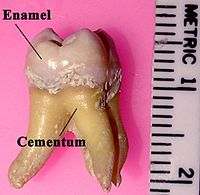
Photo from wikipedia
OBJECTIVE This study investigated the mechanism of action of different proteins/peptides (separately or in combination), focusing on how they act directly on the native enamel surface and on modifying the… Click to show full abstract
OBJECTIVE This study investigated the mechanism of action of different proteins/peptides (separately or in combination), focusing on how they act directly on the native enamel surface and on modifying the salivary pellicle. METHODS A total of 170 native human enamel specimens were prepared and submitted to different treatments (2 h; 37 °C): with deionized water, CaneCPI-5, Hemoglobin, Statherin, or a combination of all three proteins/peptides. The groups were subdivided into treatment acting on the enamel surface (NoP - absence of salivary pellicle), and treatment modifying the salivary pellicle (P). Treatment was made (2 h; 37 °C) in all specimens, and later, for P, the specimens were incubated in human saliva (2 h; 37 °C). In both cases, the specimens were immersed in 1% citric acid (pH 3.6; 2 min; 25 °C). Calcium released from enamel (CaR) and its relative surface reflection intensity (%SRI) was measured after 5 cycles. Between-group differences were verified with two-way ANOVA, with "presence of pellicle" and "treatment" as factors (α = 0.05). RESULTS The presence of pellicle provided better protection regarding %SRI (p < 0.01), but not regarding CaR (p = 0.201). In relation to treatment, when compared to the control group, all proteins/peptides provided significantly better protection (p < 0.01 for %SRI and Car). The combination of all three proteins/peptides demonstrated the best protective effect (p < 0.01 for %SRI). CONCLUSION Depending on the protein or peptide, its erosion-inhibiting effect derives from their interaction with the enamel surface or from modifying the pellicle, so a combination of proteins and peptides provides the best protection. CLINICAL SIGNIFICANCE The present study opens a new direction for a possible treatment with a combination of proteins for native human enamel, which can act directly on the enamel surface as well on the modification of the salivary pellicle, for the prevention of dental erosion.
Journal Title: Journal of dentistry
Year Published: 2021
Link to full text (if available)
Share on Social Media: Sign Up to like & get
recommendations!